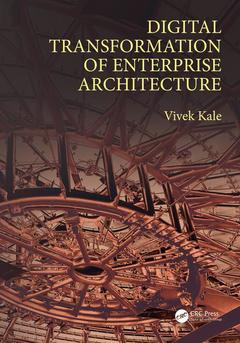Description
Digital Transformation of Enterprise Architecture
Author: Kale Vivek
Language: English
Subjects for Digital Transformation of Enterprise Architecture:
Keywords
Enterprise Architecture; Processing Systems; Business Process; Wireless Sensor Networks; Vice Versa; enterprise processes; IoT Device; modern enterprise architecture; Execution Time; business models; ERP System; agile enterprise; Virtual Machine; RFID Tag; Context Aware Systems; Virtual Nodes; Big Data Computing; Common Language; Cloud Computing; ADL; Role Based Access Control; Smart Phone; Spatio Temporal Databases; Steady State Availability; Digital Transformation; IP Address; Model Driven Interoperability; Atm Card; Sensor Nodes; Cloud Service Providers; Mod
Approximative price 184.47 €
In Print (Delivery period: 14 days).
Add to cart· 17.8x25.4 cm · Hardback
Description
/li>Contents
/li>Biography
/li>
"In this book, Vivek Kale makes an important contribution to the theory and practice of enterprise architecture ? this book captures the breadth and depth of information that a modern enterprise architecture must address to effectively support an agile enterprise. This book should have a place in every practicing architect's library."
?John D. McDowall, Author of Complex Enterprise Architecture
Digital Transformation of Enterprise Architecture is the first book to propose Enterprise Architecture (EA) as the most important element (after Business Models) for digital transformation of enterprises. This book makes digital transformation more tangible by showing the rationale and typical technologies associated with it, and these technologies in turn reveal the essence of digital transformation. This book would be useful for analysts, designers and developers of future-ready agile application systems.
This book proposes that it is the perennial quest for interoperability & portability, scalability, availability, etc., that has directed and driven the evolution of the IT/IS industry in the past 50 years. It is this very quest that has led to the emergence of technologies like service-oriented, cloud, and big data computing. In addition to the conventional attributes of EA like interoperability, scalability and availability, this book identifies additional attributes of mobility, ubiquity, security, analyticity, and usability.
This pragmatic book:
- Identifies three parts effort for any digital transformation: Business Models, Enterprise Architectures and Enterprise Processes.
- Describes eight attributes of EA: interoperability, scalability, availability, mobility, ubiquity, security, analyticity, and usability.
- Explains the corresponding technologies of service-oriented, cloud, big data, context-aware, Internet of Things (IoT), blockchain, soft, and interactive computing.
- Briefs on auxiliary technologies like integration, virtualization, replication, spatio-temporal databases, embedded systems, cryptography, data mining, and interactive interfaces that are essential for digital transformation of enterprise architecture.
- Introduces interactive interfaces like voice, gaze, gesture and 3D interfaces.
- Provides an overview of blockchain computing, soft computing, and customer interaction systems.
Digital Transformation of Enterprise Architecture proposes that to withstand the disruptive digital storms of the future, enterprises must bring about digital transformation, i.e. a transformation that affects an exponential change (amplification or attenuation) in any aspect of the constituent attributes of EA. It proposes that each of these technologies (service-oriented, cloud, big data, context-aware, IoT, blockchain, soft, and interactive computing) bring about digital transformation of the corresponding EA attribute viz. interoperability, scalability, availability, mobility, ubiquity, security, analyticity, and usability.
Foreword
Preface
Acknowledgments
Author
Other Books by Vivek Kale
Prologue: Digital Storms
1. Agile Enterprise Architecture
Section I Genesis of Digital Transformation of Enterprise Architecture
2. Systems Theory
3. Digital Transformation of Enterprises
4. Distributed Systems
Section II Road to Digital Transformation of Enterprise Architecture
5. Dependability
6. Performability
7. Interoperability
8. Scalability
9. Availability
10. Mobility
11. Ubiquity
12. Security
13. Analyticity
14. Usability
Section III Digital Transformation of Enterprise Architecture
15. Service-Oriented Computing
16. Cloud Computing
17. Big Data Computing
18. Context-Aware Computing
19. Internet of Things (IoT) Computing
20. Blockchain Computing
21. Soft Computing
22. Interactive Computing
Epilogue: Blown to Bits
Bibliography
Index
These books may interest you

Cloud Enterprise Architecture 68.67 €

Cloud Enterprise Architecture 148.11 €


